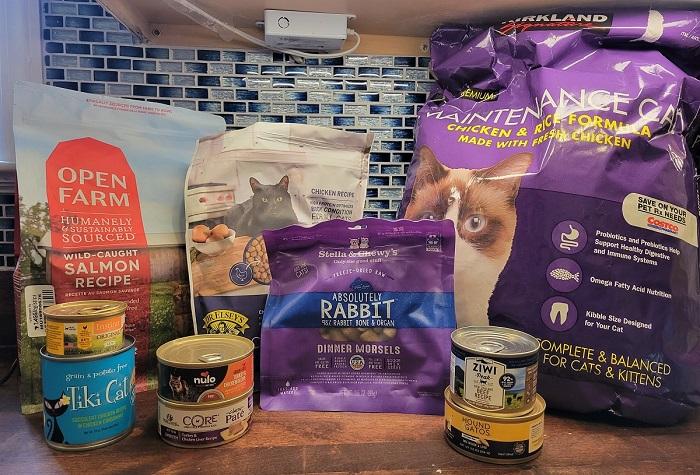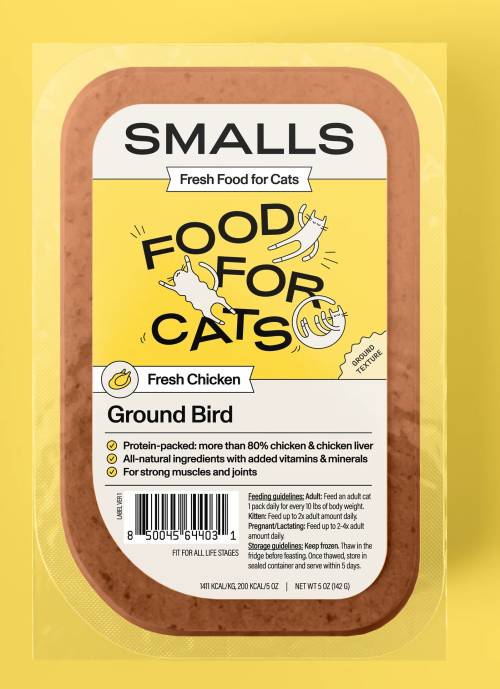The 10 Best-Tasting Cat Foods for Picky Cats (original) (raw)

Kate Barrington / Cats.com
In many cases, cats refuse to eat because they don’t like the aroma, flavor, or texture of their food. But sometimes finicky eating habits are a sign of an underlying issue. Either way, if you find yourself shopping for new cat food, it helps to understand what factors affect your cat’s preferences.
In this guide, we’ll explore the factors that affect feline food preferences and common causes for refusing food. We’ve also included in-depth reviews of our top 10 picks for the best cat food for picky cats.
At a Glance: Best Cat Foods for Picky Cats
Overall Best

10.0
Picked by 31 people today!
Smalls Ground Bird Fresh Cat Food
- Made with a single source of animal protein
- Flavor and texture appeal to many cats
- Low in carbohydrates
GET 35% OFF ENTER "CATS35" TO GET 35% OFF YOUR FIRST ORDER
Why Trust Cats.com

Kirsten McCarthy / Cats.com
As the owner of three cats with unique preferences, I’ve tried countless cat food recipes over the years. My personal experience influenced my picks, but the recipes included in this guide have been tested with over half a dozen of our team’s cats. The products tested were purchased at full retail price and, in several cases, samples were sent to an ISO 17025-certified food testing laboratory for detailed chemical analysis.
During testing, I made general observations about how the food looked and smelled in addition to its texture, consistency, and packaging. My three cats offered their opinions on taste and general appeal. I also performed an in-depth evaluation of the product information and each brand, taking into account other customers’ experiences by reading hundreds of reviews.
What to Consider When Feeding a Picky Cat
It’s frustrating when your cat suddenly starts refusing a food they’ve previously enjoyed—especially if you’ve already bought a case of it. Before you panic, try warming up the food or mixing it with some kind of flavor additive like broth or shredded chicken. If that fails, you may be stuck shopping for a new cat food entirely.
Before you start shopping, consider why your cat is refusing their food. It’s worth consulting your veterinarian to rule out underlying medical issues, but sometimes your cat just loses the taste for something. Understanding how a cat forms their preferences for food may be helpful when it comes time to select a new diet. Here are four things you should know.
1. Food Preferences Form at a Very Young Age
Your cat’s preferences begin to form before they’re even born. What the mother ate during gestation and nursing and the type of food used during weaning can influence your cat’s food preferences. The types, flavors, and textures of food your kitten is exposed to when still young play a role as well.
2. Cats Typically Prefer Foods That Have a Strong, Appealing Aroma
Aroma is a major factor in a cat’s decision to eat or refuse food. Even if the food smells terrible to you, it’s likely to be much more appealing to your can than a less odorous food.
Wet food tends to have a stronger smell than dry cat food. Refrigerating wet food, however, can dull the smell. If your cat is refusing wet food on the second day, try letting it come to room temperature or warm it for a few seconds in the microwave.
3. Some Cats Have Specific Preferences for Texture or Shape
As humans, we often eat with our eyes—how food looks influences whether we want to eat it or not. Cats can form preferences for food shapes and textures too. In a small 2020 study, researchers determined that cats prefer flat disc, x-shaped, or star-shaped kibbles over triangles and cylinders. Of those options, the flat disc shape seemed to be most palatable to cats.
Wet cat food comes in a wide variety of textures including paté, minced, and shredded. Some patés are completely smooth while others contain pieces of meat or vegetables. The moisture content affects the texture as well. Minced and shredded foods are often made in gravy or broth which changes the texture.
4. Dental Disease and Medical Problems May Be a Factor
If your cat has bad teeth or other dental issues, it could make it difficult or uncomfortable for them to eat. Your cat might refuse the dry food they’ve always accepted but might be perfectly happy to eat softer wet food.
Certain health problems are influenced by diet as well. While your cat may not be aware that higher-moisture wet food is better than dry food for kidney disease, they may sense at some level that they don’t feel as well eating dry food. Allergies or food sensitivities may also turn a cat off to a certain food before physical symptoms become obvious.
The Best Cat Food for Picky Cats: Our Top 10 Picks
Our top pick for picky cats is Smalls Fresh Ground Bird. Made with a single source of animal protein, this fresh cat food formula is packed with hydrating moisture, species-appropriate animal protein, and healthy fats.
Keep in mind, however, that each cat has their own unique preferences. Our experts’ experience with these foods may not match your experience, so you’ll have to do some trial-and-error testing of your own to find out what your cat likes. To help you get started, we’ve broken down our recommendations by food type, price, and other key factors.
Outside of the preference for meat-based foods, feline dietary likes and dislikes aren’t universal. The frustrating thing for many cat owners is that a cat’s preferences can change on a dime. It may take time to find a recipe your cat consistently enjoys and, even then, they might change their mind months or even weeks later. It never hurts to keep a few backup cans of alternate flavors on hand, just in case.
Frequently Asked Questions
What do you feed a picky cat that won’t eat?
Some cats are simply finicky by nature and all you can do is try different types and flavors of food until you find something they’ll eat. Warming the food, mixing it with broth, or adding a food topper might help. Smell plays a significant role in food appeal, so if all else fails, try offering something smelly like water from a can of tuna or anchovies.
How long can a picky cat go without eating?
Just like humans, cats can survive longer without food than water. While a cat might survive as long as two weeks without food, lack of proper nutrition will negatively impact their health. Your cat is at risk of developing fatty liver disease after just a couple days of no eating. And if your cat typically eats a high-moisture diet, refusal to eat may also lead to dehydration. Contact your veterinarian if your cat refuses to eat for more than 48 hours.
Why does my cat act hungry but won’t eat?
If your cat appears hungry but suddenly starts refusing food, it’s best to seek veterinary help. Refusal of food can be a sign of nausea or other digestive issues like constipation, pancreatitis, or inflammatory bowel disease. If your vet gives your cat the all-clear, you may simply need to try offering different types of food to catch their interest.
